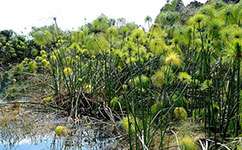Papyrus charcoal offers new fuel source

Turning local sources of underused biomass like maize cobs or papyrus stems into charcoal briquettes could provide better fuel for people across East Africa, scientists suggest. This new, sustainable energy source could help boost local economies, curb rampant deforestation and avert health problems caused by inhaling smoke from firewood.
Researchers led by Dr Ed Morrison of the University of Leicester focused on the area around Lake Naivasha in Kenya. Thick beds of papyrus - a giant member of the sedge family - grow around the lake's margins, and right now the locals aren't putting them to much use. Initial trials suggest they could be turned into high-quality domestic fuel. 'They've got this hugely productive resource on their doorsteps, and they're not really taking advantage of it,' says Morrison.
At the moment the most common fuel for people across sub-Saharan Africa is charcoal made from wood. This often comes from trees that were illegally cut down and contributes to the devastation of many of the continent's woodlands. Just 2-3 per cent of Kenya is now forested - far below what scientists think is sustainable. And because the charcoal is made with traditional methods - set fire to a pile of wood and then cover it with soil, effectively - it's wasteful; only 10 - 14 per cent of the wood's mass ends up as charcoal.
It also often travels long distances by truck, driving prices higher; as forests are cut back even more, that trend is only going to continue. For those who can't pay, or when supplies are scarce, the alternative is to spend hours searching for uncarbonized firewood, which burns faster and produces much more smoke, often causing lung problems when burned indoors. Local and sustainable fuel sources are needed across East Africa; Morrison wondered if plentiful papyrus could be the answer.
As a visiting fellow at Harvard University, Morrison worked with co-author Dr Amy Banzaert of Wellesley College in the US using a design for a charcoal kiln pioneered by MIT's Fuel from the Fields project. The kiln is made of an oil drum and other cheap, common materials, and anyone can download the plans online . It turns wood to charcoal more efficiently than the traditional method, and removes many of the most harmful volatile compounds that would otherwise be released in wood smoke.
The researchers harvested the biggest stems of papyrus, turned them into charcoal, mixed it with a binding agent and compressed it into briquettes using simple presses made from scrap metal. Finally, they gave samples to 32 local households and asked them to rate how satisfactory they were as fuel. The response was encouraging; more than 84 per cent said the briquettes were as good as, or even better than, wood charcoal.
The idea isn't entirely new; local people around Lake Victoria already burn papyrus if they can't get any better fuel, although it's unsatisfactory; bulky, smoky and too quick to burn. Other researchers have suggested using the papyrus beds for fuel, but they've tended to advocate clear-cutting them - a practice Morrison says isn't sustainable, as it means removing too many nutrients from the wetland.
Instead, the study used only fully-grown papyrus stems to give the rest of the plant a chance to recover. Even with this more limited harvesting, the authors estimate the lake's papyrus could meet more than 85 per cent of the district's household fuel needs, provided a biannual harvest proves sustainable in the long term.
The possibilities range from small cottage industries making charcoal for their communities to much larger operations. Morrison thinks it might be worth local groups establishing their own papyrus plantations or setting about restoring degraded wetlands - this would let them grow more biomass than the lake can provide, as well as avoiding the encounters with hippos and snakes that are an occupational hazard when harvesting papyrus from the lake itself. It would also benefit the wider lake ecosystem, as papyrus and other wetland plants remove pollutants from water.
Morrison says that while not everywhere in the region has plentiful supplies of papyrus, many other kinds of organic waste could be used for charcoal - from bagasse, the remains from sugar cane processing, to maize cobs, tea and coffee waste or coconut husks.
One of Morrison's current projects, in partnership with La Terre Clean Energy Ltd., involves trying to find a use for the waste produced by the area's flourishing cut flower industry; stems, leaves and imperfect blooms could be turned into charcoal, or into gas that can be used for heating or power generation. 'Whilst some farms compost their waste, those less scrupulous simply set it alight when they run out of space to store it,' he says. 'We suddenly realised that a large part of the answer to the question of more sustainable and affordable sources of energy for the local community may be lying right on their doorstep.'
The flow of knowledge isn't only from scientists to locals; Morrison says one Kenyan entrepreneur he knows has already made big improvements to the kiln design, making it much easier to stop the influx of air once the organic matter inside has caught fire.
The paper appears in Wetlands Ecology and Management. NERC and the Economic and Social Research Council supported Morrison's PhD; additional funding came via the Ecosystem Services for Poverty Alleviation (ESPA) programme.
More information: Morrison, E. et al. Biomass briquettes: a novel incentive for managing papyrus wetlands sustainably? Wetlands Ecology and Management. DOI: 10.1007/s11273-013-9310-x
Provided by PlanetEarth Online
This story is republished courtesy of Planet Earth online, a free, companion website to the award-winning magazine Planet Earth published and funded by the Natural Environment Research Council (NERC).
















